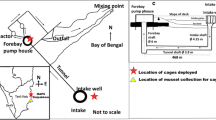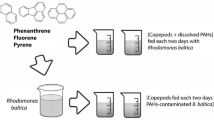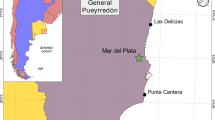Abstract
Cyclic organochlorines are highly hydrophobic chemicals which usually possess a high persistence to microbial breakdown. These behavioural aspects determine the suitability of each environmental compartment for monitoring purposes, which is discussed.
It is concluded, that monitoring of (cyclic) organochlorines should only be executed for compounds about which solid information is available on their environmental behaviour in abiotic and biotic environmental compartments. Under these conditions benthic invertebrates which use glycogen as their main energy-depot, appear to be the most suitable tool for environmental monitoring of lipophilic compounds. Concentrations should be expressed on the basis of (total) extractable lipids.
The organisms to be compared should be sampled at a time when they have a similar physiological condition. This does not automatically mean synoptic sampling.
Multi-component mixtures, such as PCB's, should be monitored on the basis of (selected) individual components in order to account for differences in behaviour of each component between different environmental compartments and animal species.
Some representatives of the compounds discussed are strong inducers of mixed function oxygenase (MFO) enzyme systems. Therefore it should be investigated, if monitoring of MFO activity in addition to concentrations can be regarded as an early warning system of additive effects.
Similar content being viewed by others
References
Addison, R. F., Zinck, M. E., and Willis, D. E.: 1977, ‘Mixed Function Oxidase Enzymes in Trout (Salvelinus fontinalis) Liver: Absence of Induction Following Feeding of p,p'-DDT or p,p'-DDE’. Comp. Biochem. Physiol. 57C, 39–43.
Addison, R. F., Zinck, M. E., and Willis, D. E.: 1981, ‘Time-and Dose-Dependence of Hepatic Mixed Function Oxidase Activity in Brook Trout Salvelinus Fontinalis on Polychlorinated Biphenyl Residues: Implications for ‘Biological Effects Monitoring’’, Environ. Pollut. Ser. A 25, 211–218.
Ballschmiter, K., Buchert, H., Bihler, S., and Zell, M.: 1981, ‘Baseline Studies of the Global Pollution IV. The Pattern of Pollution by Organochlorine-Compounds in the North Atlantic as Accumulated in Fish’, Z. Analyt. Chem. 306, 323–339.
Ballschmiter, K. and Zell, M.: 1980, ‘Analysis of Polychlorinated Biphenyls (PCB) by Glass Capillary Gas Chromatography. Composition of technical Aroclor and Clophen-PCB Mixtures’, Z. Analyt. Chem. 302, 20–31.
vanBennekom, A. J.: 1978, ‘Overlap tussen de verspreiding van Rijn-en Scheldewater in de Noordzee’, in J. T. F.Zimmerman (ed.), Texel 1978. Waterbeweging en menging in het zuidelijke gedeelte van de Noorzee, NIOZ, Texel, pp. 43–60.
vanBennekom, A. J., Gieskes, W. W. C., and Tijssen, S. B.: 1975, ‘Eutrophication of Dutch Coastal Waters’, Proc. R. Soc. Lond. B. 189, 359–374.
Boon, J. P.: 1985, ‘Uptake, Distribution and Elimination of Selected Polychlorinated Biphenyl Components of Clophen A40 in Juvenile Sole (Solea solea) and Effects on Growth’, in J. S.Gray and M. E.Christiansen (eds.), Eighteenth European Marine Biology Symposium, ‘Marine Biology of Polar Regions’ and ‘Effects of Stress on Marine Organism’, John Wiley and Sons Ltd, Chichester, pp. 493–512.
Boon, J. P. Oudejans, R. C. H. M., and Duinker, J. C.: 1984, ‘Kinetics of Individual Polychlorinated Biphenyl (PCB) components in Juvenile Sole (Solea solea) in Relation to Concentrations in Food and to Lipid Metabolism’, Comp. Biochem. Physiol. 79C, 131–142.
Boon, J. P., vanZantvoort, M. W., Govaert, M. J. M. A., and Duinker, J. C.: 1985, ‘Organochlorines in Benthic Polychaetes (Nephtys spp.) and Sediments from the Southern North Sea. Identification of Individual PCB Components’, Neth. J. Sea Res. 19, 93–109.
Bopp, R. F., Simpson, H. J., Olsen, C. R., Tier, R. M., and Kostyk, N.: 1982, ‘Chlorinated Hydrocarbons & Radionuclide Chronologies in Sediments of the Hudson river and Estuary, New York’, Environ Sci. Technol. 16, 666–676.
Bruggeman, W. A.: 1983, ‘Bioaccumulation of Polychlorobiphenyls and Related Hydrophobic Chemicals in Fish‘, Thesis, University of Amsterdam, 160 pp.
Bruggeman, W. A., Martron, L. B. J. M., Kooiman, D., and Hutzinger, O.: 1981, ‘Accumulation and Elimination of di-, tri-, and tetrachlorobiphenyls by Goldfish after Dietary and Aqueous Exposure’, Chemosphere 10, 811–832.
Bruggeman, W. A., van derSteen, J., and Hutzinger, O.: 1982, ‘Reversed Phase Thin-Layer Chromatography of Polynuclear Aromatic Hydrocarbons and Chlorinated Biphenyls. Relationship with Hydrophobicity as Measured by Aqueous Solubility and Octanol-Water Partition Coefficient’, J. Chromat, 238, 335–346.
Bruggeman, W. A., Weber-Fung, D., Opperhuizen, A., van derSteen, J., Wijbenga, A., and Hutzinger, O.: 1984, ‘Absorption and Retention of Polydimethylsiloxanes (Silicones) in Fish: Preliminary Experiments’ Toxicol. Environ. Chem. 7, 287–296.
Creutzberg, F. and Postma, H.: 1979, ‘An experimental Approach to the Distribution of Mud in the Southern North Sea’, Neth. J. Sea Res. 13, 99–116.
Doskey, P. V. and Andren, A. W.: 1981, ‘Concentrations of Airborne PCBs over Lake Michigan’, J. Great Lakes Res. 7, 15–20.
Doskey, P. V. and Andren, A. W.: 1981, ‘Modelling the Flux of Atmospheric Polychlorinated Biphenyls Across the Air-Water Interface’, Environ. Sci. Technol. 15, 705–711.
Duinker, J. C., Boon, J. P., and Hillebrand, M. T. J.: 1984, ‘Organochlorines in the Dutch Wadden Sea’, Neth. Inst. Sea Res. Publ. Ser. 10, 211–228.
Duinker, J. C. and Hillebrand, M. T. J.: 1983a, ‘Characterization of PCB Components in Clophen Formulations by Capillary GC-MS and GC-ECD Techniques’, Environ. Sci. Technol. 17, 449–456.
Duinker, J. C. and Hillebrand, M. T. J.: (1983b), ‘Composition of PCB Mixtures in Biotic and Abiotic Marine Compartments (Dutch Wadden Sea)’, Bull. Environ. Contam. Toxicol. 31, 52–32.
Duinker, J. C. and Hillebrand, M. T. J.: 1983c, ‘Determination of Selected Organochlorines in Seawater’, in Grasshoff, K., M. Ehrhardt, and K. Kremling (eds.), Methods of Seawater Analyses, 2nd ed., Chapter 12.4, Verlag Chemie, pp. 290–309.
Duinker, J. C., Hillebrand, M. T. J. and Boon, J. P., 1983, ‘Organochlorines in Benthic Invertebrates and Sediments from the Dutch Wadden Sea; Identification of Individual PCB Components’, Neth. J. Sea. Res. 17, 19–38.
Duinker, J. C., Hillebrand, M. T. J., Nolting, R. F., and Wellershaus, S.: 1982a, ‘The River Elbe: Processes Affecting the Behaviour of Metals and Organochlorines During Estuarine Mixing’, Neth. J. Sea. Res. 15, 141–169.
Elcombe, C. R. and Lech, J. J.: 1979, ‘Introduction and Characterization of Hemoproteins(s) P-450 and Monooxygenation in Rainbow Trour (Salmo gairdneri)’, Toxicol. Appl. Pharmacol. 49, 437–450.
Galloway, W. B., Lake, J. L., Phelps, D. K., Rogerson, P. F., Bowen, V. T., Farrington, J. W., Goldberg, E. D., Laseter, J. L., Lawler, G. C., Martin, J. H., and Risebrough, R. W.: 1983, ‘The Mussel Watch: Intercomparison of Trace Level Constituent Determinations’, Environ. Toxicol. Chem. 2, 395–410.
Goerke, H. and Ernst, W.: 1980, ‘Accumulation and Elimination of 14C-γ-HCH (lindane) in Nereis virens (polychaeta) with Consideration of Metabolism’, Helgoländer Meeresunters. 33, 313–326.
Guiney, P. D., Melancon, M. J., Lech, J. J., and Peterson, R.E.: 1979, ‘Effects of Egg and Sperm Maturation and Spawning on the Distribution and Elimination of Polychlorinated Biphenyl in Rainbow Trout (Salmo gairdneri)’, Toxicol. Appl. Pharmacol. 47, 261–272.
Holden, A. V. and Marsden, K.: 1969, ‘Single Stage Clean-up of Animal Tissue Extracts for Organochlorine Residue Analysis’, J. Chromat. 44, 481–492.
Jansson, B., Jensen, S., Olsson, L., Renberg, L., Sundström, G., and Vaz, R.: 1975, ‘Identification by GC/MS of Phenolic Metabolites of PCB and p,p'-DDE Isolated from Baltic Guillemot and Seal’, AMBIO 4, 93–97.
Kautsky, H.: 1973, ‘The Distribution of the Radio Nuclide Caesium-137 as an Indicator for North Sea Water Mass Transport’, Dt. Hydrogr. Z. 26, 241–246+Plates 4–9.
Kramer, C. J. M.: 1986, ‘Monitoring of Abiotic Compartments for Trace Metals: Difficulties, Strategies and the Use of Surveys’, Environmental Monitoring and Assessment 7, 169–187 (this issue).
Laevastu, T.: 1963, Surface Water Types of the North Sea and their Characteristics, Serial Atlas of the marine environment, Folio 4. New York (Am. Geogr. Soc.).
Langston, W. J.: 1978, ‘Accumulation of Polychlorinated Biphenyls in the Cockle Cerastoderma Edule and the Tellin Macoma Balthica’, Mar. Biol. 45, 265–272.
Lee, R. F.: 1981, ‘Mixed Function Oxygenases (MFO) in Marine Invertebrates’, Mar. Biol. Lett. 2, 87–105.
Lee, R. F., Sauerheber, R., and Dobbs, G. H.: 1972, ‘Uptake, Metabolism and Discharge of Polycyclic Aromatic Hydrocarbons by Marine Fish’, Mar. Biol. 17, 201–208.
Malish, R.: 1981, ‘Sedimente als Modelle für die Beurteilung der Umweltkontamination durch chlororganische Pestizide, polychlorierte Biphenyle und Phtalate unter besonderer Berücksichtigung des zeitlichen Verlaufs’, Thesis, University of Münster, 260 pp.
Malish, R., Schulte, E., and Acker, L.: 1981, ‘Chlororganische Pestizide, polychlorierte Biphenyle und Phtalate in Sedimenten aus Rhein und Neckar’, Chen. Z. 105, 178–194.
Melancon, M. J., Elcombe, C. R., Vodicnik, M. J., Lech, J. J.: 1981, ‘Induction of Cytochromes P 450 and Mixed-functions Oxidase Activity by Polychlorinated Bipenyls and β-Naphtoflavone in Carp (Cyprinus carpio)’, Comp. Biochem. Physiol. 69C, 219–226.
Payne, J. F. and Penrose, W. R.: 1975, ‘Induction of Aryl Hydrocarbon (benzo [a] pyrene) Hydroxylase in Fish by Petroleum’, Bull. Environ. Contam. Toxicol. 14, 112–116.
Safe, S., Parkinson, A., Robertson, L., Safe, L., and Bandiera, S.: 1982, ‘Polychlorinated Biphenyls: Effects of Structure on Biologic and Toxic Activity’, in Workshop on the Combined Effects of Xenobiotics, Ottawa, Canada; June 22–23, Publ. NRCC/CNRC no 18978 of the environmental secretariat, Natl. Res. Council Canada, pp. 151–176.
Shaw, G. R. and Connell, D. W.: 1984, ‘Physiochemical Properties Controlling Polychlorinated Biphenyl (PCB) Concentrations in Aquatic Organisms’, Environ. Sci. Technol. 18, 18–23.
Södergren, A. and Larsson, P.: 1982, ‘Transport of PCBs in Aquatic Laboratory Model Ecosystems from Sediment to the Atmosphere via the Surface Microlayer’, AMBIO 11, 41–45.
Solbakken, J. E. and Palmork, K. H.: 1981, ‘Metabolism of Phenanthrene in Various Marine Animals’, Comp. Biochem. Physiol. 70C, 21–26.
Suijlen, J. M.: 1981, ‘Quasisynoptische saliniteitsmetingen in de zuidelijke Noordzee (oostzijde)’, Rapport 07 81 F, fys. afd. directie waterhuishouding en waterbeweging, Rijkswaterstaat.
Tanabe, S. and Tatsukawa, R.: 1980, ‘Chlorinated Hydrocarbons in the North Pacific and Indian Oceans’, J. Oceanogr. Soc. Japan 36, 217–226.
Tausch, H., Stehlik, G., and Wihlidal, H.: 1981, ‘Analysis of Organochlorine Pesticides and PCB Residues in Fish by Capillary GC-MS’, Chromatographia 14, 403–410.
Tuinstra, L. G. M. TH., Driesen, J. J. M., Keukens, H. J., vanMunsteren, T. J., Roos, A. H., and Traag, W. A.: 1983, ‘Quantitative Determination of Specified Chlorophenyls in Fish and Its Use for Monitoring and Tolerance Purposes’, Intern J. Environ. Anal. Chem. 14, 147–157.
Veith, G. D., deFoe, D. L., and Bergstedt, B. V.: 1979, ‘Measuring and Estimating the Biocentration Factor in Fish’, J. Fish. Res. Board Can. 36, 1040–1048.
Voogt, P. A.: 1983, ‘Lipids: Their Distribution and Metabolism’, in The Mollusca, Vol. 1: Metabolic biochemistry and molecular biomechanics. Academic Press, pp. 329–370.
Yoshida, T., Takashima, F., and Watanabe, T.: 1973, ‘Distribution of [14C] PCBs in Carp’. AMBIO 2, 111–113.
Author information
Authors and Affiliations
Rights and permissions
About this article
Cite this article
Boon, J.P., Duinker, J.C. Monitoring of cyclic organochlorines in the marine environment. Environ Monit Assess 7, 189–208 (1986). https://doi.org/10.1007/BF00398696
Issue Date:
DOI: https://doi.org/10.1007/BF00398696




